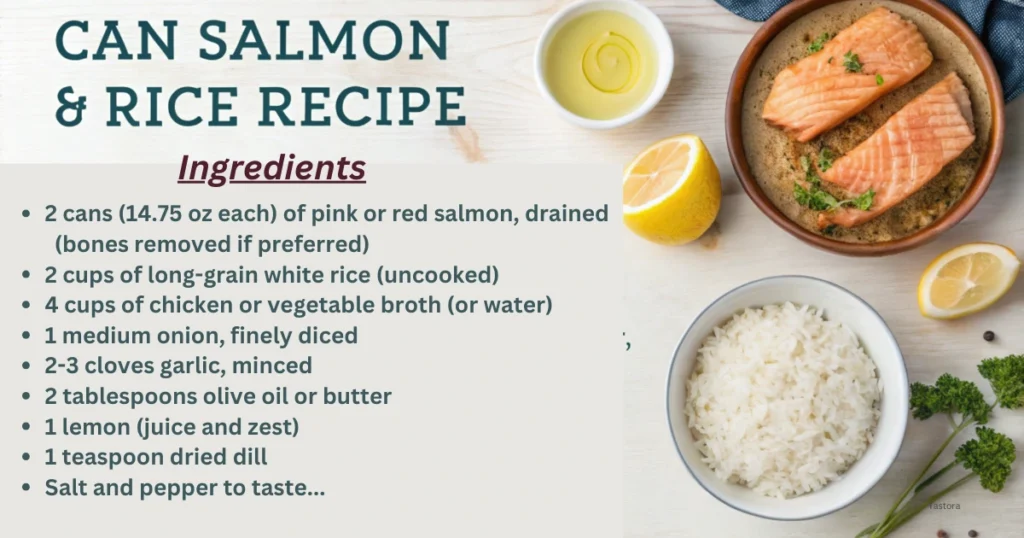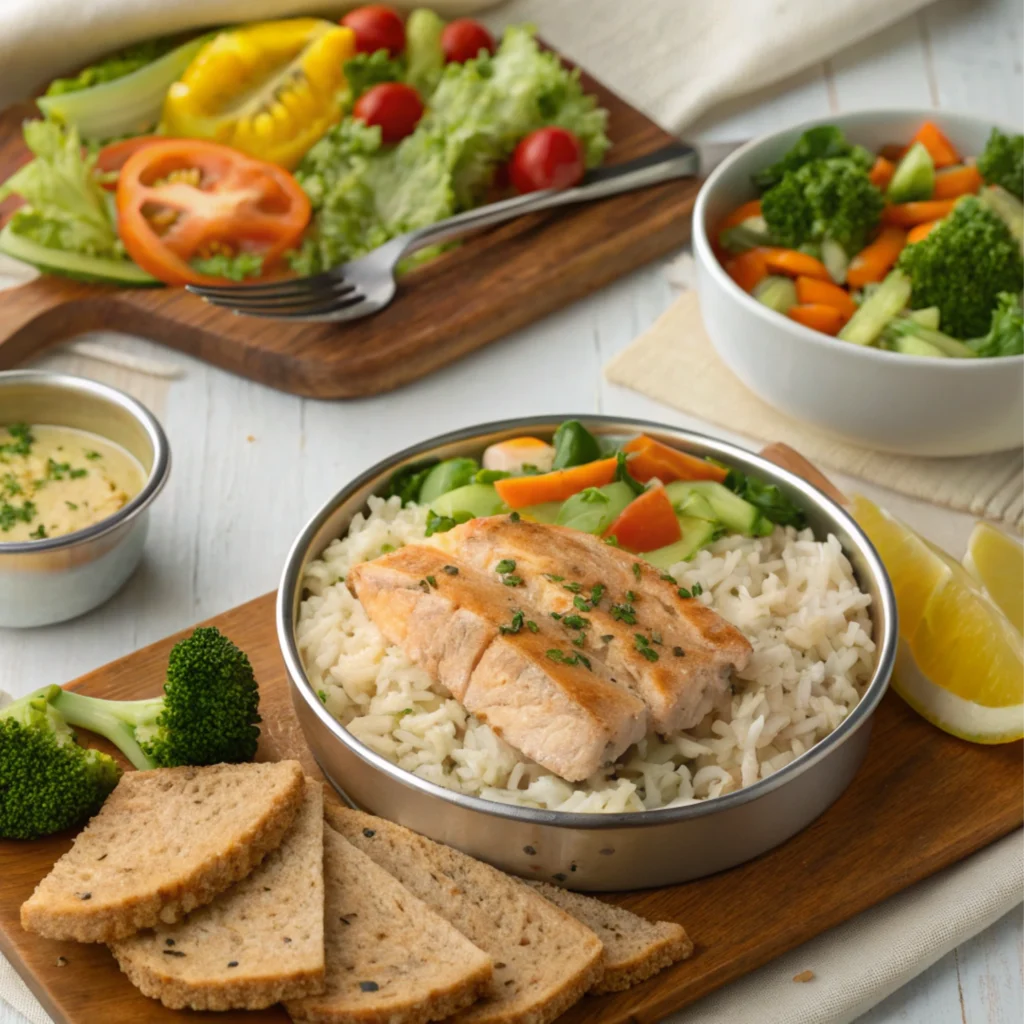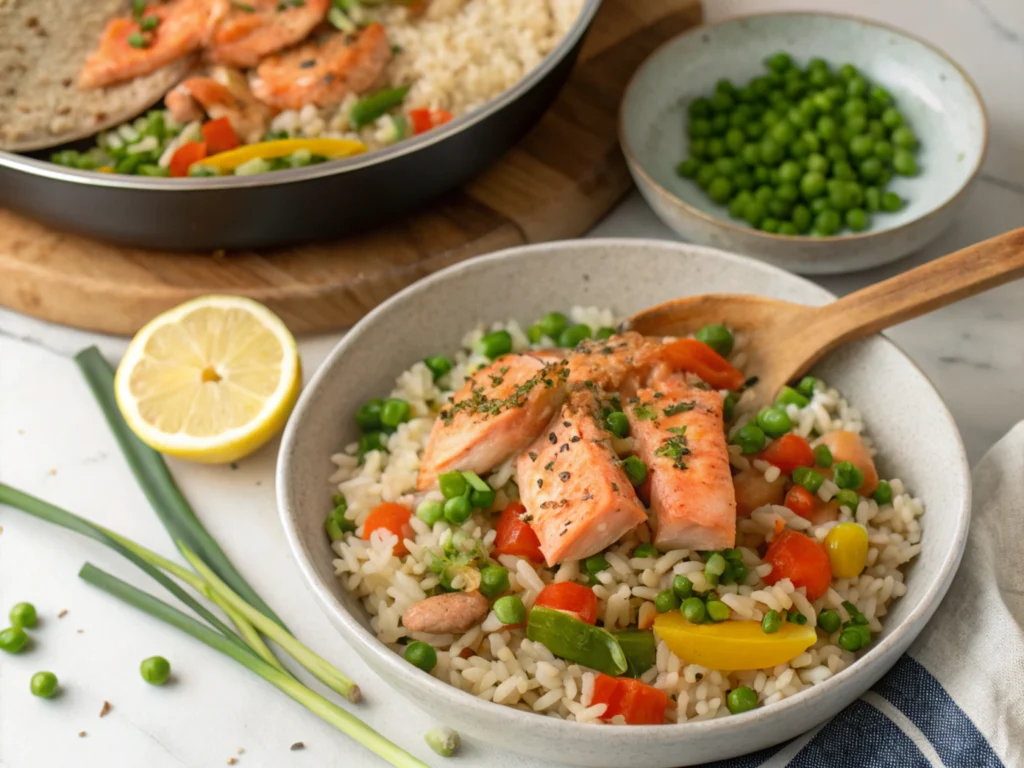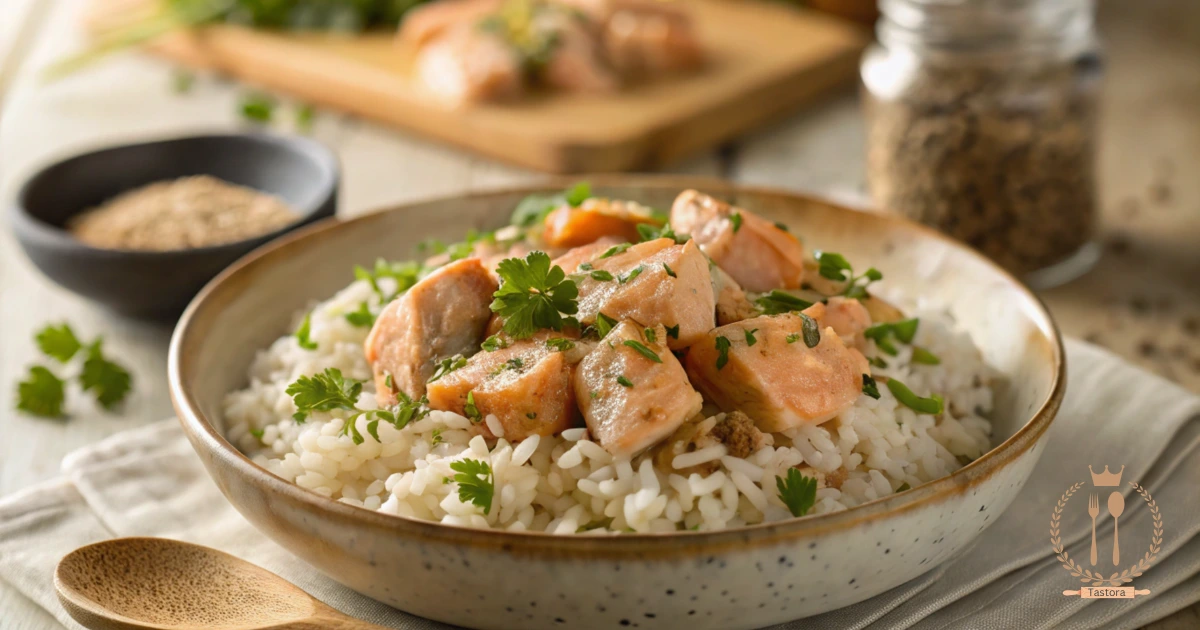How to Make the Best Can Salmon and Rice Recipe at Home
Discover the ultimate pantry-to-plate miracle that’s transforming weeknight dinners across America! Our Can Salmon and Rice Recipe brings together two humble ingredients to create a dish that’s surprisingly sophisticated yet incredibly practical. In a world of complicated recipes and expensive ingredients, this budget-friendly powerhouse delivers protein-packed nutrition without sacrificing flavor or breaking the bank. Perfect for busy professionals, budget-conscious families, and culinary beginners alike, this versatile dish comes together in minutes using shelf-stable ingredients you probably already have on hand. Say goodbye to expensive takeout and hello to a satisfying homemade meal that’s as nutritious as it is delicious!
Ingredients for the Best Can Salmon and Rice Recipe

Essential Pantry Heroes for Your Salmon and Rice Creation
Transform your pantry staples into a gourmet experience with these simple ingredients:
- 2 cans (14.75 oz each) of pink or red salmon, drained (bones removed if preferred)
- 2 cups of long-grain white rice (uncooked)
- 4 cups of chicken or vegetable broth (or water)
- 1 medium onion, finely diced
- 2-3 cloves garlic, minced
- 2 tablespoons olive oil or butter
- 1 lemon (juice and zest)
- 1 teaspoon dried dill
- Salt and pepper to taste
Flavor Boosters to Elevate Your Dish
Take your salmon and rice from simple to spectacular with these optional add-ins:
- 1 cup frozen peas or mixed vegetables
- ¼ cup fresh parsley or dill, chopped
- 2 tablespoons capers, drained
- ¼ cup grated Parmesan cheese
- ½ teaspoon red pepper flakes for heat
- 2 tablespoons soy sauce or 1 tablespoon fish sauce for umami depth
- ½ cup white wine for deglazing the pan
Nutritional Powerhouse on Your Plate
This dynamic duo packs a serious nutritional punch! Canned salmon delivers high-quality protein along with impressive amounts of heart-healthy omega-3 fatty acids, vitamin D, and calcium (especially if you keep the soft, edible bones). It’s one of the few non-dairy sources of calcium and vitamin D, making it valuable for bone health. Rice provides complex carbohydrates for sustained energy, while being naturally gluten-free. Together, they create a balanced meal that’s rich in protein, contains essential fatty acids, provides steady energy, and delivers key nutrients like B vitamins, selenium, and potassium—all for a fraction of the cost of fresh fish dishes.
How to Prepare Can Salmon and Rice: Step-by-Step Guide

Step 1: Prepping Your Ingredients for Success
Start by giving your canned salmon some attention. Open the cans and drain the liquid thoroughly. Transfer the salmon to a bowl and use a fork to flake it apart, removing any skin and bones if desired (though the soft bones are edible and calcium-rich). For the rice, measure it into a fine-mesh sieve and rinse under cold water until the water runs clear—this removes excess starch and prevents clumping. Prepare your aromatics by finely dicing the onion and mincing the garlic. If using additional vegetables, chop them into uniform, bite-sized pieces for even cooking. Having everything prepped before you start cooking ensures the process goes smoothly and prevents any ingredients from overcooking.
Step 2: Mastering Multiple Cooking Methods for Perfect Results
Classic Stovetop Method: In a large saucepan, heat olive oil over medium heat. Sauté the onions until translucent (about 3-4 minutes), then add garlic and cook for another 30 seconds until fragrant. Add the rinsed rice and stir to coat with oil. Pour in the broth or water, bring to a boil, then reduce heat, cover, and simmer for 15-18 minutes until the liquid is absorbed and rice is tender.
One-Pot Baked Method: Preheat your oven to 375°F. In an oven-safe pot or Dutch oven, sauté onions and garlic in oil until softened. Add rice and broth, bring to a simmer on the stovetop, then cover and transfer to the oven. Bake for 17-20 minutes until rice is tender and liquid is absorbed.
Rice Cooker Convenience: For the easiest method, add the rinsed rice, broth, a tablespoon of oil, and half of your diced onions to the rice cooker. Set to cook according to manufacturer instructions. Meanwhile, sauté the remaining onions and garlic in a separate pan until golden.
Step 3: Bringing It All Together in Harmonious Flavor
Once your rice is cooked to perfection, it’s time for the grand finale. If using the stovetop or oven method, gently fold the flaked salmon into the hot rice. For the rice cooker method, transfer the cooked rice to the pan with the sautéed aromatics, then fold in the salmon. Now, add your seasonings—the dried dill, lemon zest, lemon juice, salt, and pepper. If you’re including optional ingredients like frozen peas, add them now; the residual heat will warm them perfectly. For cheese lovers, sprinkle Parmesan over the top and allow it to melt slightly. Finally, give everything a gentle but thorough mix to distribute the flavors evenly, being careful not to break up the salmon too much. Cover and let stand for 5 minutes off the heat to allow the flavors to meld.
Best Tips for a Flavorful Can Salmon and Rice Dish

Seasoning Secrets That Make All the Difference
The key to transforming canned salmon from ordinary to extraordinary lies in thoughtful seasoning. Start with a foundation of aromatics like sautéed onions and garlic to build a flavor base. Brightening agents like lemon juice and zest cut through the richness of salmon while enhancing its natural flavor. Fresh or dried herbs—particularly dill, parsley, or chives—have a natural affinity for salmon. Don’t underestimate the power of a good finishing salt; a sprinkle of flaky sea salt just before serving can elevate the entire dish. For depth, consider adding a splash of white wine during cooking or a dash of soy sauce for umami notes. Remember that canned salmon varies in saltiness, so taste before adding additional salt. For heat lovers, a pinch of cayenne or red pepper flakes can add dimension without overwhelming the delicate fish flavor.
Texture Transformation Techniques
Achieving the perfect texture balance makes this simple dish truly satisfying. For the rice, toasting it in oil before adding liquid creates individual grains with a subtle nutty flavor. Using stock instead of water infuses the rice with flavor from the beginning. For the salmon, gentle folding rather than aggressive stirring preserves appealing chunks rather than creating a uniform mush. Consider adding textural contrasts: crunchy elements like toasted pine nuts, slivered almonds, or panko breadcrumbs provide welcome variation. For a crispy top layer, transfer the finished dish to a baking dish, sprinkle with cheese or breadcrumbs, and broil for 2-3 minutes until golden. If you prefer a creamier texture, stir in a tablespoon of cream cheese or Greek yogurt when combining the ingredients.
Customization Canvas: Making It Your Own
Think of this recipe as a versatile foundation ready for your personal touch. For a Mediterranean twist, add chopped olives, roasted red peppers, and feta cheese. Go Asian-inspired with a splash of soy sauce, sesame oil, and garnished with sliced green onions. Create a complete meal by adding vegetables: leafy greens like spinach or kale wilt perfectly into the hot rice, while frozen peas or corn add sweet pops of color and nutrition. For a deconstructed sushi bowl effect, add diced cucumber, avocado, and a sprinkle of sesame seeds with a drizzle of sriracha mayo. Turn leftover salmon and rice into crispy patties by adding an egg and breadcrumbs, then pan-frying until golden. The possibilities are endless—let your pantry and preferences guide your creativity!
Serving Suggestions: What Goes Well with Can Salmon and Rice?
Perfect Pairings: Side Dishes That Complement
Complete your meal with sides that enhance without overshadowing your salmon and rice centerpiece. Bright, acidic salads create welcome contrast—consider a simple arugula salad with lemon vinaigrette or a cucumber-tomato salad with red wine vinegar dressing. Roasted vegetables add depth: asparagus, brussels sprouts, or a medley of root vegetables roasted until caramelized complement the dish beautifully. For a heartier option, garlic bread or dinner rolls make excellent companions for sopping up any savory juices. In warmer months, serve alongside chilled dishes like a crisp coleslaw or corn and black bean salad for refreshing texture contrast. For a more substantial spread, add steamed or sautéed greens like kale, Swiss chard, or broccolini with a squeeze of lemon and a sprinkle of red pepper flakes.
Sauce Sensations and Flavor Finishers
Elevate your salmon and rice with finishing touches that add moisture and flavor complexity. A dollop of Greek yogurt mixed with lemon and dill creates a creamy, tangy sauce that enhances the salmon. For heat lovers, sriracha mayo (simply mix mayonnaise with sriracha to taste) adds creamy spice. A classic dill sauce made with sour cream, chopped dill, lemon juice, and a touch of Dijon mustard complements the salmon beautifully. For Asian-inspired flavors, a drizzle of teriyaki glaze or a simple sauce of soy sauce, rice vinegar, and a touch of honey works wonders. Don’t forget the power of a good compound butter: mix softened butter with herbs, lemon zest, and minced garlic, then melt a pat over the hot dish just before serving. Even a simple drizzle of quality olive oil and a sprinkle of flaky sea salt can enhance the dish remarkably.
Master Meal Prep: Make-Ahead Magic and Storage Solutions
Transform this quick dinner into a meal prep champion with these practical tips. For make-ahead preparation, cook the rice and prepare the salmon mixture separately, storing in the refrigerator for up to 2 days before combining and reheating. The fully prepared dish stores beautifully in airtight containers in the refrigerator for 3-4 days, making it perfect for planned leftovers. For freezing, portion the combined dish into freezer-safe containers, leaving slight headspace for expansion, and freeze for up to 3 months. To prevent drying when reheating, add a tablespoon of water or broth before microwaving covered, or reheat in a skillet with a touch of olive oil. For a refreshed leftover experience, try serving cold salmon and rice over salad greens with a vinaigrette dressing, or form into patties for salmon cakes the next day. Portion into grab-and-go containers with a side of vegetables for convenient workday lunches that will have colleagues eyeing your meal with envy.
Frequently Asked Questions About Can Salmon and Rice
Exploring Rice Varieties: Finding Your Perfect Match
Absolutely! While long-grain white rice is the standard, this recipe welcomes experimentation with various rice types. Brown rice provides a nuttier flavor and additional fiber—just adjust cooking time to about 45 minutes and add slightly more liquid. Aromatic rice varieties like jasmine or basmati bring distinctive fragrance and flavor that pairs beautifully with salmon. For a creamy, risotto-like texture, arborio rice works wonderfully—use the traditional risotto method of gradually adding hot broth while stirring. Wild rice offers rustic texture and earthy flavor, though it requires longer cooking (about 45-60 minutes). For faster prep, instant rice works in a pinch—just adjust liquid amounts according to package directions. Cauliflower rice makes an excellent low-carb alternative; simply sauté it briefly before folding in the salmon and seasonings. Each rice variety brings its own character to the dish, so consider what texture and flavor profile you prefer.
Healthier Horizons: Nutritional Upgrades and Modifications
Enhancing the nutritional profile of this already healthy dish is simple with thoughtful modifications. Swap white rice for brown, wild, or black rice varieties to increase fiber and micronutrients. Boost vegetable content by incorporating finely chopped spinach, kale, shredded carrots, or bell peppers—aim for a 50/50 ratio of vegetables to rice. Reduce sodium by choosing low-sodium broth and rinsing the canned salmon well before use. For increased omega-3 content, add a tablespoon of ground flaxseed or chia seeds. If watching calories, use cooking spray instead of oil when sautéing aromatics and emphasize herbs and citrus for flavor rather than higher-calorie additions like cheese. For those monitoring carbohydrates, cauliflower rice provides a vegetable-based alternative to traditional rice. Add extra protein with a hard-boiled egg or edamame. By thinking of this dish as a template rather than a rigid recipe, you can easily adjust it to align with various dietary preferences while maintaining its fundamental appeal.
Seasoning Strategies: Flavor Profiles for Canned Salmon
Canned salmon’s rich flavor provides the perfect canvas for various seasoning approaches. For traditional flavor pairings that never disappoint, the classic combination of dill, lemon, and black pepper enhances salmon’s natural taste. Experiment with herb blends like herbs de Provence or Italian seasoning for European flair. For Asian-inspired dishes, consider a combination of ginger, garlic, green onions, and a touch of sesame oil. Cajun or blackened seasoning adds southern heat that stands up well to salmon’s richness. Smoked paprika imparts a subtle smokiness that mimics the flavor of smoked salmon. Fresh herbs make a significant difference—try combinations like dill and parsley, or cilantro and lime for brightness. Don’t overlook the power of acid; a splash of white wine vinegar or a squeeze of citrus cuts through richness and brightens flavors. For depth, consider incorporating umami elements like a touch of miso paste, soy sauce, or even anchovy paste. Remember that canned salmon can vary in saltiness, so taste before adding additional salt to your seasonings.
Are you ready to try this recipe?
There are no reviews yet. Be the first one to write one.


